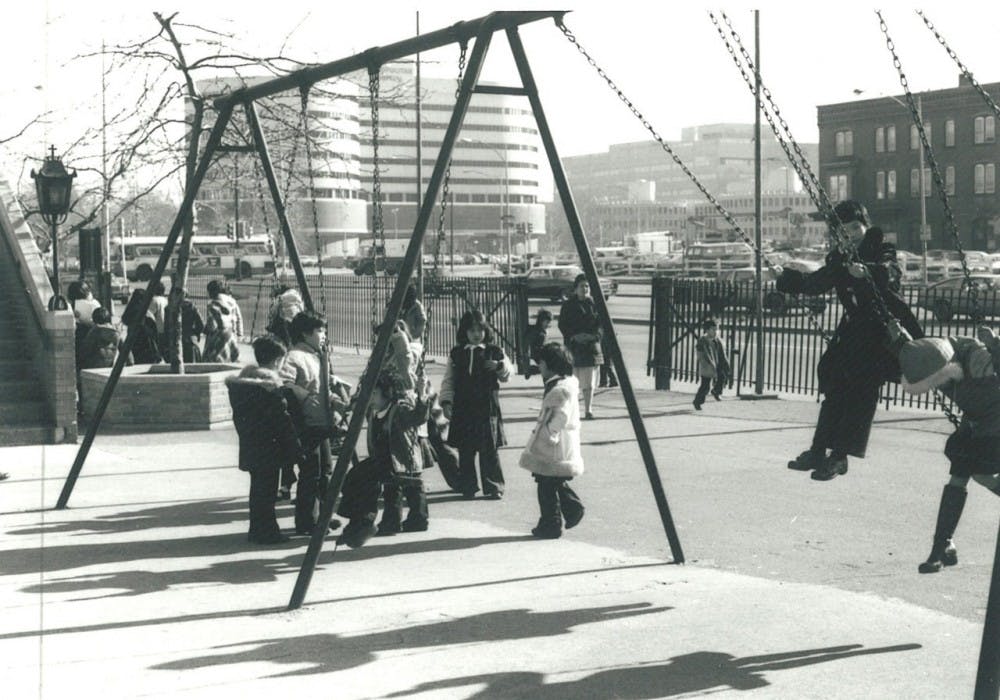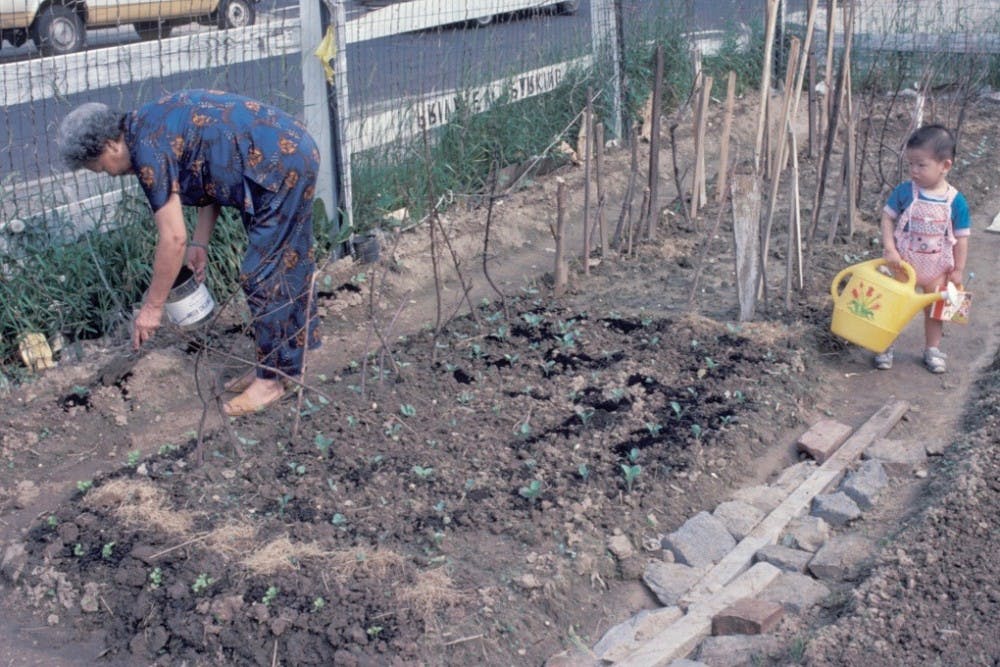
The schoolyard of the Holy Redeemer Chinese Catholic Church and School opened in 1941. The Expressway demolished parts of the schoolyard and physically separated Holy Redeemer from Chinatown proper. (Photo provided by Philadelphia Chinatown Development Corporation archives)
For the last 50 years, developments of all forms, including a baseball stadium, a casino, and a detention center, have been proposed both inside of and surrounding Chinatown. Another proposal by a large developer, which calls for the implementation of a Business Improvement District in Chinatown North, could further threaten this immigrant community. A BID is a commercial district in which all the property owners must pay an annual fee in exchange for special services such as cleaning, greening, and lighting.
Historically, Chinatown North has served as the hub for many immigrant-owned factories, industries, and businesses. In the late 1900s, it became the home to nonprofits such as Philadelphia Chinatown Development Corporation, Asian Arts Initiative, and the first public charter school to serve Chinatown: FACTS Charter School. In 2017, Arts and Crafts Holdings, a real estate development company, and a group of large property owners began planning a Callowhill Business Improvement District (CBID) in Chinatown North. There are currently at least 15 BID’s operating in Philadelphia, including the Center City and University City districts. Notably, Arts and Crafts has invested nearly $325 million into redeveloping Chinatown North.
Arts and Crafts is known for renovating old factories into upscale lofts, but it has proven itself to be a negligent landlord when it comes to actually maintaining its properties. In 2018, past and present Arts and Crafts tenants spoke up about months of delayed maintenance, blocked fire exits, and threatening letters outlining steep rent increases and sudden lease termination. One resident even went to the ER due to black mold growing in their unit.
During the CBID planning process, the CBID Board was required to hold at least two public hearings, which property owners inside the affected area and anyone with a say were allowed to attend. The most common concerns brought up during these meetings were trash and safety. Many property owners complained about the unsightliness of the litter in the area and how they felt unsafe walking in the streets at night. This rhetoric seemed to suggest that Chinatown North was a desolate landscape filled with blight, drugs, and trash, as if working class folks and immigrants had not lived there all along. But over the past few years, the development in Chinatown North seems to cater toward the “creative class” in the form of luxury condominiums, art galleries, and creative work spaces, and from 2000 to 2010, the white population in Chinatown doubled according to a 2013 report by the Asian American Legal Defense and Education Fund — all indicators of gentrification.
Chinatown Community Garden that used to be located on the corner of 10th and Vine Street. It was demolished for the Expressway. (Photo from Philadelphia Chinatown Development Corporation archives)
Across America, Chinatowns have served as the gateway for immigrants from Asia to receive and access culturally appropriate and affordable housing, food, and social services, and form valuable social networks. Asians are the fastest growing racial group in the U.S., and recently became the racial group with the largest income gap in the U.S. AALDEF reports that median rents nearly doubled in Chinatown between 2000 and 2010. In 2018, the zip code 19123 that comprises Chinatown North, Callowhill, Northern Liberties, and West Poplar was ranked among the top 10 most gentrified neighborhoods in the nation.
In the 1970s, despite fierce protests from the community, the Vine Street Expressway demolished parts of Chinatown and separated what is now known as Chinatown North from Chinatown proper. In 1991, the opening of the Pennsylvania Convention Center led to the destruction of 200 homes in Chinatown. These are only some of the developments that have threatened to harm this community, and none of them took into consideration the lives of the people who lived here.
Today, Chinatown has lost more than a quarter of its original land, and is surrounded on all sides by the Pennsylvania Convention Center, the Fashion District, and the Constitution Center. The only way Chinatown can really grow is northward, across the Expressway. Meanwhile, Arts and Crafts continues to invest in and rapidly redevelop properties in Chinatown North. So if this proposed BID, which is led by a development company that has a questionable track record, comes to fruition, what effect would it have on the working class immigrant community of Chinatown?
In order for the CBID to be defeated, at least one third of the property owners within the proposed BID boundaries must submit objection letters by August 9. However, we can all support equitable development that uplifts minority and working class voices rather than the voices of developers who do not represent the neighborhoods in which they build. We can also do our part to show up and protest against construction projects that may threaten to encroach on Chinatown in the future. More than ever, it is urgent that we protect what is left.
BRITTANY XIAO is a College senior from Houston, Texas majoring in Urban Studies. She plays violin in the Penn Symphony Orchestra and Penn Chamber. Her email address is xiaobrit@sas.upenn.edu.
The Daily Pennsylvanian is an independent, student-run newspaper. Please consider making a donation to support the coverage that shapes the University. Your generosity ensures a future of strong journalism at Penn.
Donate




